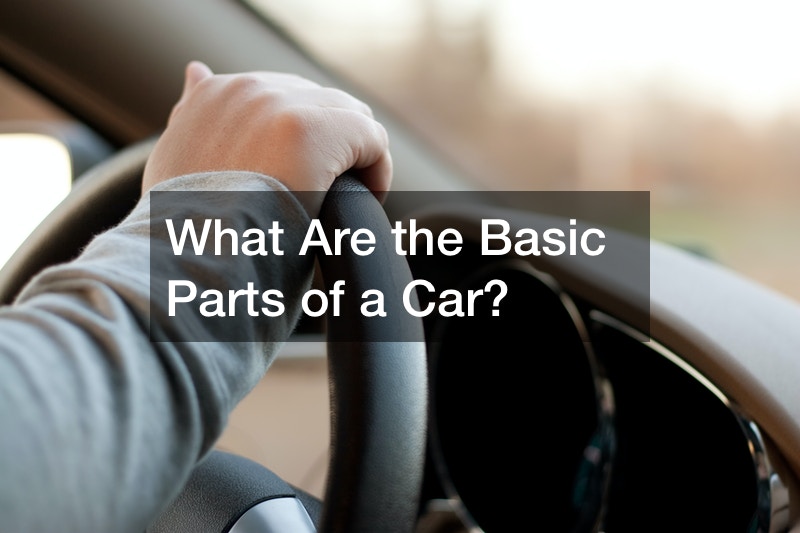What Are the Basic Parts of a Car?

If you are excited to learn more about cars or need to know what are the basic parts of a car that compose them, here we go over the parts that make the vehicle function properly, whether you are driving a used car or a new car.
Chassis
The chassis is the skeleton of a car. It can be a self-supporting structure, such as a shell or type H (ladder), where the rest of the vehicle is mounted. The chassis is the main structure where all the components of the vehicle will be mounted including the car flooring. Are you still wondering what are the basic parts of a car?
Bodywork

The bodywork is the structure that is arranged on the chassis to house the occupants and the vehicle’s load. In the case of self-supporting chassis, the bodywork is included in the structure and only adds aesthetic elements.
Wheels

All vehicles have four tires or wheels. No vehicle can drive without four good car wheels. These have to be kept in good shape and changed for the winter season to adapt to the icy roadways.
The Brake System
What are the basic parts of a car as it relates to the brake system? Brakes are a complex system where mechanical, hydraulic, and electronic subsystems are combined that allow us to stop a vehicle that weighs more than 1,000 kilos and is moving at high speed with a gentle push of our foot. This system consists of a pedal that transmits force to a brake booster, and then, this device multiplies the energy and transfers it to the wheels, using a special liquid that is not compressed. The brake system can fail due to natural wear of brake parts, or unforeseen problems, such as factory defects, external damage, or bad driving habits.
Many of these shortcomings will gradually be noticed, which unfortunately causes the driver to get used to and adapt to the malfunction of the system, looking for patch solutions for these challenges that the vehicle presents. Well, that is something to avoid, because these failures, without realizing it, are increasing over time and can be potentially dangerous.
Drum Brakes
The drum brake is a braking system where metal shoes press against the inside of a metal drum. These shoes are coated with different alloys and materials that help achieve efficient braking.
Brake Disc
The brake disc is a system where a metal disc accompanies the wheel and is braked by two pads using hydraulic pressure. This system represents an improvement to the drum system, since it achieves better results in braking and temperature management, and is currently the system most used by automobile manufacturers.
When to Change Brake Disc
Check the discs and see if they are the right thickness. On the side, you should be able to tell how much they should measure and if they are in good condition as well as if the level of thickness they have is equal to or less than the one that is inscribed. If that is the case, you must change them. This information can also be found in your vehicle’s manual. You should periodically check the status of the disks, especially when you reach 10,000 to 30,000 kilometers traveled.
There are times when discs get scratched and that is also a reason to change them (regardless of whether the thickness is fine). This is easy to notice as a strange braking noise is usually heard if discs are scratched.
Discs may also warp due to overheating. You will be able to notice this since when the discs are deformed, a small vibration is felt at the wheel when braking. If the discs have this anomaly, you must change them.
Check discs regularly, because if discs change color (turn bluish) also due to overheating, they should be replaced immediately.
When discs are rusted, they tend to break to form fissures. This is not so usual, although in itself it is an urgent reason for the change.
Brake Pads

Brake pads are equal to or more important than discs since both are part of your car’s braking system. This is why you should check it frequently from time to time, and change them if necessary. You can change the pads and not the discs if they are still useful, however, when you change the discs, you must change the pads. When it comes to car maintenance, the brake pads are one of the first elements that need to be replaced because due to their function, they wear out faster than the other parts of the brake system.
Therefore, when the time comes to change them, you must choose between many alternatives offered by the market, among which are ceramic tablets, organic tablets, or semi-metallic tablets. The best pickup for your car will not depend on its materiality or its price, since each pickup is designed for different requirements. You just have to opt for a recognized brand whose products are accepted by the manufacturer of your vehicle.
When the driver steps on the brake pedal, the brake pads press on the brake disc, forcing it to stop and this disc, in turn, exerts pressure on the wheels and seals them. Going into more detail, the brake pads are contained in a caliper, which is a part that, in addition, has two pistons that press on the brake pad, so that later the process of stopping the wheel is triggered by the effect of friction.
Brake Pedal
It is the system that allows a small push of the foot on the brake pedal to become the pressure necessary to stop a heavy vehicle in motion. Currently, depending on vehicle technology, this brake booster can be hydraulic, pneumatic, or electric.
Softer Pedal
This problem may be an indication of a brake fluid leak or deterioration of brake fluid from prolonged use. It can also be due to a malfunction of some parts or the presence of air in the ducts. If you notice that your brakes are getting softer, you should take the vehicle to the workshop or used car dealership immediately.
Hard Brake Pedal
The force that you apply to the pedal reaches a system called the brake booster that is responsible for multiplying the power and sending it to the wheels. If this part starts to do its job poorly, it will make the pedal feel stiffer. This problem should be checked immediately by experts as it is very dangerous if the pedal does not respond, especially in emergency braking.
Handbrake or Parking Brake
What are the basic parts of a car? The parking brake is an auxiliary brake system that, as its name implies, is activated to permanently immobilize the vehicle when it is parked. This system was generally operated by means of a lever located between the driver and the passenger behind the gear lever. Today, electronic braking systems are relieving this function and have been adding new features, such as automatic brake activation and deactivation, hill start aid, among others.
Motor or Engine
The engine is the heart of a car. It is the element that allows the movement and operation of almost all the auxiliary systems that allow driving. New technologies have allowed new vehicles to have smaller and less polluting engines, leaving large and noisy engines in the past. The engines, according to their technology, can move with various sources of energy, among which are gasoline, diesel, gas, electricity, among many others. It is very costly to do an engine repair and that is why it is so important to take care of it.
Exhaust system
What are the basic parts of a car? The exhaust system is made up of chambers and tubes, especially to direct the gas away from the engine and to keep the noise of the engine down. The gases directed from the engine are carbon dioxide, nitrogen, carbon monoxide, hydrocarbons, water vapor, and nitrogen oxide. The primary elements of the exhaust system are the manifold, resonator, muffler, exhaust pipes, catalytic converter, oxygen sensors, and tailpipe. An exhaust system repair can be complex, but a good auto mechanic knows what to do.
Airbags
Presented by Mercedes Benz in 1981 in an S-class model, airbags became an indispensable passive safety device in a car, so much so that world regulations aim to make them mandatory in all vehicles. The airbag system consists of airbags that, through impact sensors, can inflate in hundredths of seconds, managing to protect the vehicle’s occupants in the event of a strong impact. This is also one of the essential dodge charger parts.
Suspension

What are the basic parts of a car? The suspension consists of a set of parts and systems that seek to reduce vibrations produced by road imperfections. Generally, elements such as springs, hydraulic shock absorbers, metal leaf springs, among other elements, are used. The arrangement of these elements and their configuration gives the vehicle special characteristics, such as smoothness, load capacity, maneuverability, and stability.
The Transmission
The transmission of a car corresponds to a system that is composed of a set of elements that are responsible for transferring the power generated in the engine to the wheels of the vehicle so that it can move. What elements make up the transmission of a vehicle? The parts that are part of the transmission system of a car are the following:
Gearbox: Gearboxes are themselves a system in charge of transforming the speed that has occurred in the mechanics of the vehicle, in order to adapt it to the speed that you want. A gearbox can be manual or automatic and is located between the clutch and the drive shaft.
Clutch: Corresponds to a part that is located between the flywheel and the gearbox, whose purpose is to couple or uncouple the engine revolutions. In this way, the clutch allows the engine transmission to be disconnected on the vehicle, in order to achieve a progressive gear change and thus a smooth start. The clutch is a fundamental part of the operation of a vehicle since it allows connecting and disconnecting of the permanent rotation of the engine to the wheels so that they move only when necessary. This is achieved thanks to the coupling and uncoupling of discs located between the engine and the transmission box. This function makes the gearbox work and its correct use can regulate the power that is sent to the wheels in certain situations.
Differential: What are the basic parts of a car? This element is a set of gears whose purpose is to allow the driving wheels to rotate at different speeds, in this way, it helps to avoid traction problems when taking a corner. This part is essential for a vehicle to be able to make curves. This, because it achieves that the uniform movement of the traction wheels is transformed into different movements when making a turn, allowing the wheel that remains on the inside of the turn to have fewer turns than the wheel that goes on the outside of the turn.
Transmission Shaft: Transmits the movement from the gearbox to the drive shaft. This element is attached to the gearbox but is only present in vehicles that have the engine on a different axis than the wheels it moves, such as cars with a front engine, but whose traction is rear. Transmission bearings or semi-shafts: These elements are bars that transfer the movement directly to the driving wheels.
: This element corresponds to the device that gives the force and speed to the wheels that move the car. Its objective is to maintain a constant sum of speeds generated by the drive wheels so that the outer wheels turn more than the inner wheels in curves and thus prevent the vehicle from skidding.
Types of Transmission
The transmission system that we have already broken down in the previous point can be manual or automatic.
Manual transmission: In this mode, the one who modifies the transmission ratio is the driver through the gear lever and the clutch. It is a box that is composed of gears of different sizes, which, after being coupled, generate a change in speed in the vehicle.
Automatic transmission: In this mode, there is no clutch pedal, and cars that have this type of transmission perform the gear change by themselves, making driving a simpler process, although not all people like vehicles automatic, because this type of gearbox is more expensive to maintain. This is one of the questions answered when it comes to what are the basic parts of a car?
Some tips to maintain the transmission system
If the transmission fails, fixing it is expensive. Therefore, it is advisable to take good care of the car to prevent premature wear of the parts. For this, you can consider the following points:
- Keep the tires in good condition and balanced, as well as avoid overloading the car.
- Change the transmission oil, according to the manufacturer’s instructions, which is generally every 2 years or 60 thousand kilometers.
- Always depress the clutch fully when making a gear change, so that the process is carried out with the clutch completely disengaged, and there is no friction that could wear the clutch.
- Properly maintain the cooling system of the vehicle so that the parts do not wear out.
Axels
What are the basic parts of a car? Axles are the physical or imaginary lines that join the front and rear wheels of a car. A physical axle exists when the wheels are connected to each other by a piece, which can be a transmission axle or a bar. Meanwhile, an imaginary axle exists when there is no part that joins the wheels. For example, steering wheels that are independent of each other, but rotate relative to a common axis.
Entertainment
For entertainment purposes, most people want to have car audio, especially, if you love music and want to vibe while driving. It is a way to pass the time in traffic. Most cars come with it while others do not, and you have to buy one and install it. However, this is easy to do.
Now that you know what are the basic parts of a car when you are driving a car, make sure that all the parts are in top condition, but also make sure that you are a part of a good auto insurance group for full coverage, in case something happens on the road.






